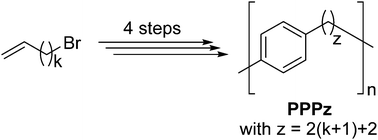Unveiling the hyperbolic thermal behaviour of poly(p-phenylene alkylene)s†
Abstract
A series of poly(p-phenylene alkylene)s with methylene run lengths ranging from 8 to 40 were obtained by ADMET polymerization of symmetrical α,ω-diene monomers and subsequent exhaustive hydrogenation. ADMET polymerizations were conducted using dibenzyl carbonate as solvent for the first time, providing materials with high molecular weights as compared with those obtained in standard solvent-free conditions. The thermal properties of both the unsaturated and saturated series were investigated. Poly(p-phenylene alkylene)s exhibit an unprecedented thermal behaviour when considering the fusion temperature as a function of the number of methylene spacers. Solid state 1H MAS and 1H–13C correlation experiments demonstrated that the melting behavior is marked by the gradual disruption of the ring π–π interactions with increasing methylene chain length. The higher crystallization tendency of longer alkyl chains was detected by the characteristic broadening of the corresponding solid-state 1H NMR signals and explains the observed increase in melting temperature with the methylene chain length.


 Please wait while we load your content...
Please wait while we load your content...